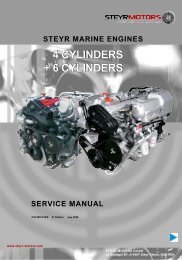ServiceManual
You also want an ePaper? Increase the reach of your titles
YUMPU automatically turns print PDFs into web optimized ePapers that Google loves.
ToC<br />
05 COOLING SYSTEM<br />
SERVICE MANUAL MARINE ENGINES<br />
05.00.02 Closed coolant from cooling circuit (internal engine cooling circuit)<br />
In the closed (primary) cooling circuit of the engine, the coolant circulates by centrifugal pump<br />
(circulating pump) mounted at the front of motorblock.<br />
The belt pulley of the pump is driven from the back of the timing belt. The pump is maintenance-free.<br />
The engine coolant in the closed circuit of the cooling system circulates as follows:<br />
The circulating pump (ill.2/1) of the engine feeds the coolant through the oil cooler (ill.2/2) where<br />
thermal energy is absorbed from motor oil.<br />
Then the coolant flows through the water jacket (ill.2/3) into the motorblock. Coolant circulates around<br />
the cylinders. Here, thermal energy of combustion is absorbed.<br />
Then coolant reaches the exhaust manifold (ill.2/4), flows through the exhaust manifold in a separate<br />
channel and absorbs thermal energy from exhaust gas.<br />
For most of 6 cyl. marine engines (excluded 256H), coolant additionally flows through the exhaust<br />
turbocharger (ill.2/5). Here, thermal energy is also absorbed from exhaust gas.<br />
Then the coolant reaches the thermostat housing. By means of thermostat, depending on the engine's<br />
operating temperature, the coolant is fed to the heat exchanger or directly to the engine coolant pump.<br />
If the engine has not yet achieved the operating temperature of 80°C, the thermostat remains closed<br />
and the coolant is fed via contact-channel directly to the intake side of coolant pump.<br />
This circulating circuit (ill.2/A) is continued until the coolant in the thermostat housing (ill.2/6a) has<br />
achieved the temperature (80°C).<br />
As soon as the temperature of 80°C in the thermostat housing is achieved, the thermostat opens and<br />
the coolant is partially (thermostat opens according to operating temperature) transmitted to the heat<br />
exchanger (ill.2/B). Via the contact-channel the coolant partially arrives directly at the intake-side of<br />
the coolant pump (ill.2/A).<br />
Only after the coolant in the thermostat housing has achieved a temperature of 90-93°C, the thermostat<br />
(ill.2/6b) is completely open. From this time, the whole coolant flows through the tube stake of heat<br />
exchanger (ill.2/7) in the exhaust manifold housing. Here, the warmed up coolant releases thermal<br />
energy to the raw water circuit, and the coolant is fed via engine water pipe to the centrifugal pump<br />
again.<br />
The heat exchanger is an integrated component of the aluminium exhaust manifold. This component<br />
also includes the expansion tank (ill.2/9) with coolant reservoir, required for the pressure system.<br />
Operating pressure is regulated via excess-pressure valve (opening pressure 0,9 bar) in the cooler<br />
cap (ill.2/10).<br />
Coolant temperature is measured by means of sensor (ill.2/11) on exhaust manifold next to drain cock<br />
(ill.2/12) of coolant, and transmitted to the electronic management system. If during operation the limit<br />
(107°C) is exceeded, the electronic management system will reduce the engine power to a perceptible<br />
extent of up to 50%.<br />
This disturbance is indicated on the instrument panel by an audible warner (2 times/sec.).<br />
ATTENTION:<br />
To avoid consecutive damages, occured trouble should be analyzed and eliminated<br />
as soon as possible.<br />
Page COOLING SYSTEM - 4 Z001019/0_6_July 2008




